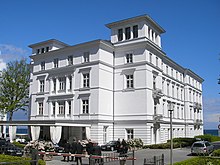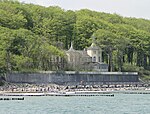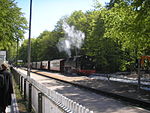|
Heiligendamm
Heiligendamm (German pronunciation: [ˈhaɪlɪɡəndam]) is a German seaside resort founded in 1793. It is the oldest seaside spa in continental Europe. Heiligendamm is part of the town Bad Doberan in the state of Mecklenburg-Vorpommern and historically belongs to Mecklenburg. The cluster of resort architecture mansions and spa buildings at the seafront are reminders of the glory days when this part of the Baltic Sea was one of the playgrounds of Europe's aristocracy.[2] Due to the classicist white buildings lining the beach promenade, the town is also known as the "White Pearl" (German: Weiße Perle) or the "White Town by the Sea" (German: Die weiße Stadt am Meer). Today, the area by the sea is occupied by a five-star hotel, the Grand Hotel Heiligendamm. A narrow-gauge steam railway, known as the "Molli", links Heiligendamm with Kühlungsborn and Bad Doberan. History  Heiligendamm was developed as an elegant meeting place for the nobility and high society. Among its most prominent guests were the German Emperors. Its founder and first guest in 1793 was the Grand Duke of Mecklenburg Friedrich Franz I; he made the resort fashionable.[2] Between 1793 and 1870, Johann Christoph, Heinrich von Seydwitz, Carl Theodor Severin, and Gustav Adolph Demmler created a veritable Gesamtkunstwerk for bathing and lodging. Heiligendamm was always regarded as the most elegant seaside resort in Germany. Nobility from throughout Europe used it as a summer getaway well into the 20th century. After the Second World War, the buildings of Heiligendamm were used as sanatoria and recovery ward. When Mecklenburg became part of the communist GDR, some of Heiligendamm's famous buildings were demolished and replaced by more utilitarian structures. After the German reunification in 1989/1990, a group of investors bought most of the buildings and undertook a major programme of refurbishment.  A new company, the Kempinski Grand Hotel, opened in spring of 2003 – it used six historical buildings including the historical Kurhaus at the beach of Heiligendamm. The development has led to some conflict with residents, as main streets and cycle paths have been removed or rerouted. Also again a famous building of the ensemble was demolished. The mansion next to the Grand Hotel was reconstructed until 2011, though. Renovations of other mansions are undergoing or planned. On July 13, 2006, United States President George W. Bush stayed at Heiligendamm while on a state visit to see German Chancellor Angela Merkel in Stralsund. On June 6 to 8, 2007, Heiligendamm's Grand Hotel hosted the 33rd summit of G8 leaders. During this time, thousands of anticapitalist activists from around the world blocked the roads to Heiligendamm and an estimated 25,000 anti-globalization protesters demonstrated in nearby Rostock.[3] In July 2013, the Grand Hotel Heiligendamm was bought by Hannover-based accountant Paul Morzynski, who intends to carefully extend and reorganize the hotel.[4] Sights The resort architecture near the beaches of Heiligendamm, consisting of classicist and historicist mansions and spa buildings, is part of a unique heritage, as the first such buildings of the European continent can be seen here. The area of the Grand Hotel is partly accessible to visitors, but should be experienced respectfully to not disturb the hotel guests. The narrow gauge railway known as Bäderbahn Molli ("Molli Resort Railway") runs through Heiligendamm from Kühlungsborn to Bad Doberan. The line between Bad Doberan and Heiligendamm was built in 1886. The Protestant Forest Church (Evangelische Waldkirche) was renovated after die Wende, the Catholic Church of the Sacred Heart (Herz-Jesu-Kapelle) is close by. Heiligendamm also has a 200-metre-long pier into the Baltic Sea that allows great views of the White Pearl Mansions at the beach.[5] Images
Literature
See alsoReferences
External linksWikimedia Commons has media related to Heiligendamm.
|
||||||||||||||||||||||||||||||||||||||||









